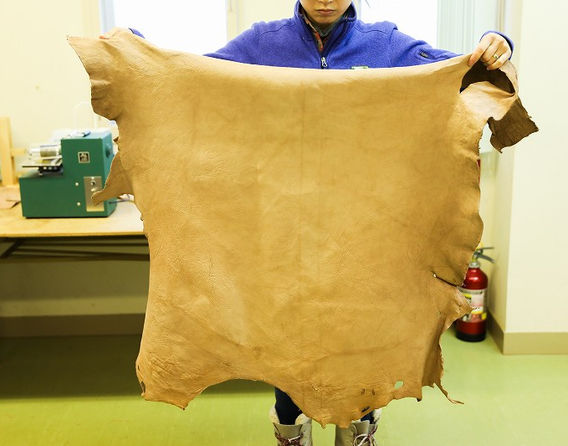Junpei & Ryoko Igota
Photo right Igota Junpei / Born in Yokohama in 1974. At university, he belongs to the mountain club and moved to Nishiokoppe village in 2006 to work on nature. Served as the secretary general of the NPO Nishiokoppe Village Hunting Zone Management Association. It also acts as a hunting guide and conducts eco-tours.
Photo left Igota Ryoko / Born in Mito, Ibaraki Prefecture. I met Junpei when I was in college and moved to 2006. Member of Nishiokoppe Village Hunting Zone Management Association.

We hunt, we tan, we create
What is tanning? The leather wallets, smartphone cases, business card holders, and bags that we use every day are tanned. According to the dictionary, "It is tanned to remove unwanted proteins and fats from the rawhide of animals and treat them with chemicals to make them durable, heat resistant and flexible." Animal skins can be tanned immediately without tanning techniques. If it rots or dries, it will become ticky.
Yoshiko Igoda (hereinafter referred to as Yoshiko) obtained a hunting license in 2007, launched the Nishiokope Ezo deer craft circle in 2011, and is working on the effective use of deer leather, which had been almost discarded until then. I'm out. It is said that he wanted to utilize the deer leather he had taken at least.
Hunting and dismantling are mainly done by Junpei Igoda (hereinafter referred to as Junpei), and Yoshiko is doing a series of tasks by dividing the roles of tanning and crafting. The hunting season in Nishiokoppe Village is from September 15th to April 15th. Winter hair deer leather is salted, and it is said that the leather is tanned from May to mid-November every year because the temperature is 20 degrees Celsius in late April, which is the best time to tan the skin. .. Yoshiko does all the tanning work by hand. Tannin tanning takes a month and a half to tan one piece, and from winter to April from December to April, the leather is mainly softened and crafted.
――― How do you come up with an idea for crafting?
Yoshiko-san I'm creating what I want and what I want. After that, we also make orders according to customer's request. Since I have been involved from scratch, I feel the joy of work when I see the smiles of our customers.
◇◇◇◇
While listening to Mr. Yoshiko's story, small and cute shoes jumped into my eyes. It is the first shoes made from deer leather that Yoshiko caught for the first time, and it is said that she gave it to her only daughter, Suzu-san, on her first birthday. I was strongly impressed by the warm look that my daughter would feel when she grew up.
――― How do you spend your days off?
Junpei-san In the spring, my family goes out to the mountains to pick up wild plants such as allium ochotense, cod sprouts, udo, and bamboo shoots. I still remember going out to pick edible wild plants with my parents and cousins when I was a kid, and I feel that this is the original experience that has been passed down to my daughter. Yamame fishing in the summer, mushroom picking and deer hunting in the fall. My daughter has been with us for deer hunting since she was 0 years old. In winter, the temperature is 20 degrees below freezing. Enjoy a frigid barbecue and an ice bar outside your log house.
I want to show the process of turning creatures into food
When I visited the log house where the couple lived, a wood-burning stove was burning and the white dog Chup (meaning the sun in Ainu) welcomed me cheerfully. "I shot two deer in the morning today." I felt Junpei's daily life very fresh. It is because the process of eating is being divided in our lives, and it is difficult to imagine what kind of process our food goes through to reach the table. I think I'll do it. Junpei also tells online from hunting to eating, eating and making good use of it.
People living in the city have a longing for Junpei's way of life and go to Nishiokoppe Village to meet him in order to experience extraordinary life. Mr. and Mrs. Igoda belong to the NPO Nishiokoppe Village Hunting Zone Management Association. Nishiokoppe Village was the first to introduce a hunting zone system in 2004, and by managing hunting in the village, it adjusts the population of Yezo deer, suppresses agricultural and forestry damage caused by deer, and is ineligible for hunters such as illegal dumping of residue. There are distinctive efforts to manage behavior. From every word of Mr. Junpei, I can feel the gratitude to the village and the people who live in the village. Thanks to the village, I felt that I enjoyed living in nature with a focus on Nishiokoppe village while valuing the connections between local people. I feel that there are many tangible and intangible treasures sleeping in Okhotsk. Would you like to experience something extraordinary for your readers?
\ The person who wrote this article /
Yuko Endo / Born in Omu-cho as the only daughter of a family who has been fishing since her great-grandfather days. After working as a student in Kyoto and working for the publishing company "Gyosei Hokkaido Branch" for 3 years, he returned to his hometown and is trying to convey the charm of Okhotsk.




